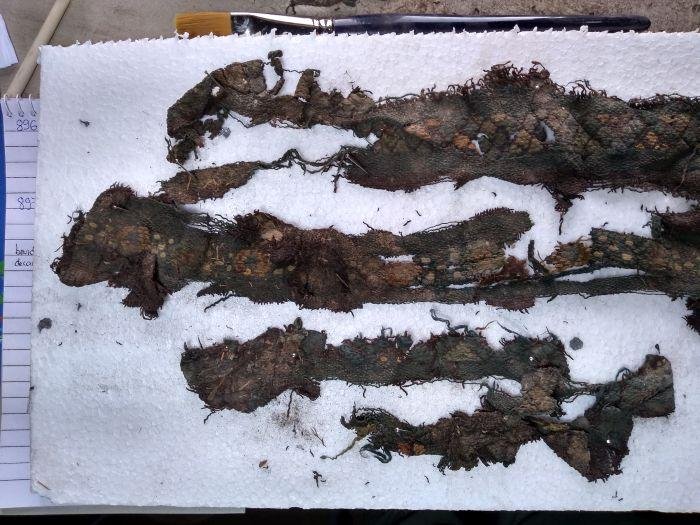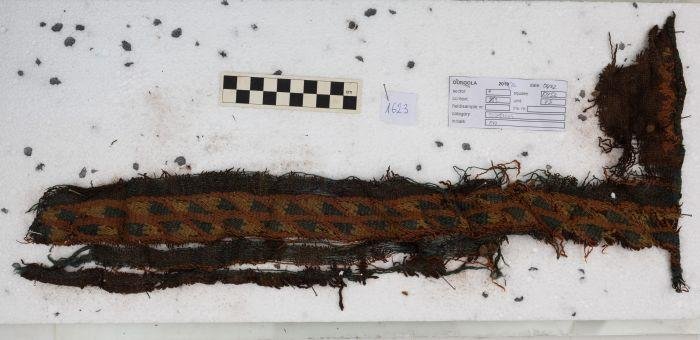Inhabitants of Old Dongola, the capital of the Kingdom of Makuria in present-day Sudan, were adept at recycling clothing due to the exorbitant cost and time-intensive nature of fabric production, as revealed by a recent study conducted by archaeologists from the University of Warsaw.
 A fragment of woolen fabric decorated using the brooch technique. Credit: Magda Woźniak PCMA UW
A fragment of woolen fabric decorated using the brooch technique. Credit: Magda Woźniak PCMA UW
The research, led by Dr. Magdalena M. Woźniak in collaboration with researchers from the Faculty of Chemistry UW, focused on fabrics dating back to the 17th and 18th centuries when the city was in decline.
Old Dongola, situated on the eastern banks of the River Nile, was a thriving urban center during the zenith of the Makurian Kingdom between the 9th and 11th centuries CE. The city, founded within the walls of a 5th-century fortress, played a crucial role in trade as a departure point for caravans heading west to Darfur and Kordofan.
The study, published in the journal Archaeometry, involved a chemical analysis of 17 fabric samples, predominantly dyed in shades of blue.
 Fragment of woolen fabric with a decorated edge and lace. Credit: Mateusz Rekłajtis, PCMA UW
Fragment of woolen fabric with a decorated edge and lace. Credit: Mateusz Rekłajtis, PCMA UW
According to Dr. Wożniak from the University of Warsaw, the inhabitants of Old Dongola were resourceful in their approach to clothing, recognizing the value of materials and maximizing their use. The recycling process involved utilizing fabrics for multiple purposes, starting as clothing and then repurposed as patches, blankets, or even as insulation against the wind. This practice was driven by the labor-intensive process of fabric production, which included growing cotton, harvesting, spinning, and weaving.
The majority of garments discovered in Old Dongola were made from wool, albeit of slightly lower quality than contemporary standards. Sheep in Sudan were primarily bred for milk and meat, with wool serving as a secondary product. Dr. Woźniak highlighted the significance of well-preserved remnants of recycled fabrics, particularly those with decorative edges, which showcased durability and attractiveness through dyeing.
Women in Old Dongola typically wore unsewn woolen garments, wrapping large pieces of fabric around themselves with decorated edges, while men predominantly wore sewn cotton garments resembling dresses. The color blue, a favorite among the residents, not only contributed to visual appeal but also held symbolic significance as a protective color against evil.
Dyeing in Old Dongola was a meticulous process due to the scarcity and expense of certain colors, especially blue. Importantly, only the wealthiest residents could afford entirely dyed fabrics. Dyeing was done in small containers, and the amount of colored thread was limited, with fabrics decorated during weaving using upholstery or brocading techniques.
The study also illuminated the use of plant and animal dyes, with woad and locally growing madder providing blue and yellow colors, respectively. Dr. Woźniak highlighted the prevalence of dyer’s broom in the fabrics, a plant extensively used in Europe during that period. Additionally, blue-dyed cotton was identified, often imported from Egypt.
Imported products, including fabrics, consтιтuted over half of the imports in Old Dongola, reflecting the city’s vibrant trade connections. Other desired products such as tin, lead, small metal items, spices, and beads – even from Europe or distant India – reached Nubia through the Nile and the desert, as emphasized by Dr. Woźniak.
The investigation in Old Dongola, which was started in 1964 by Professor Kazimierz Michałowski and is currently conducted by scientists from the Center for Mediterranean Archaeology at the University of Warsaw, has secured financial support from the European Research Council.





